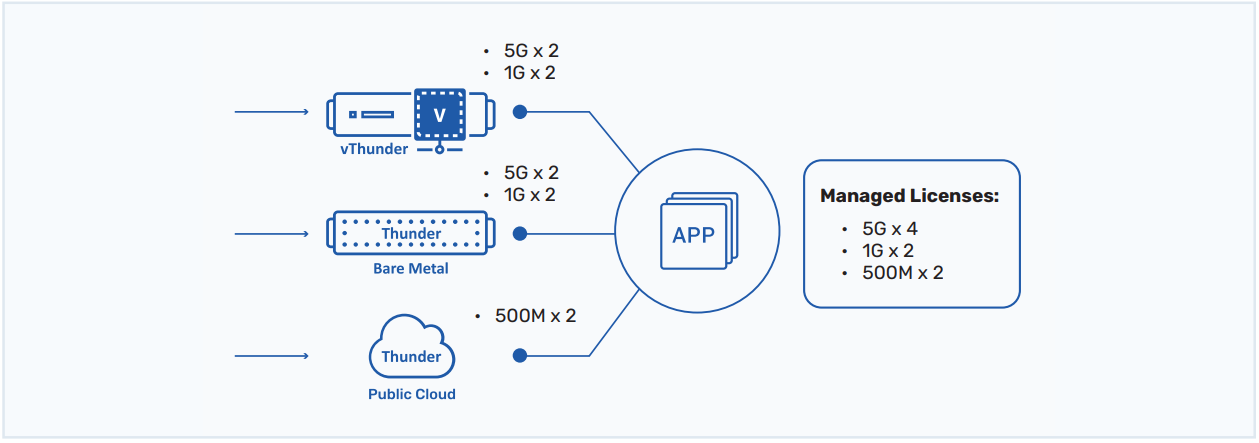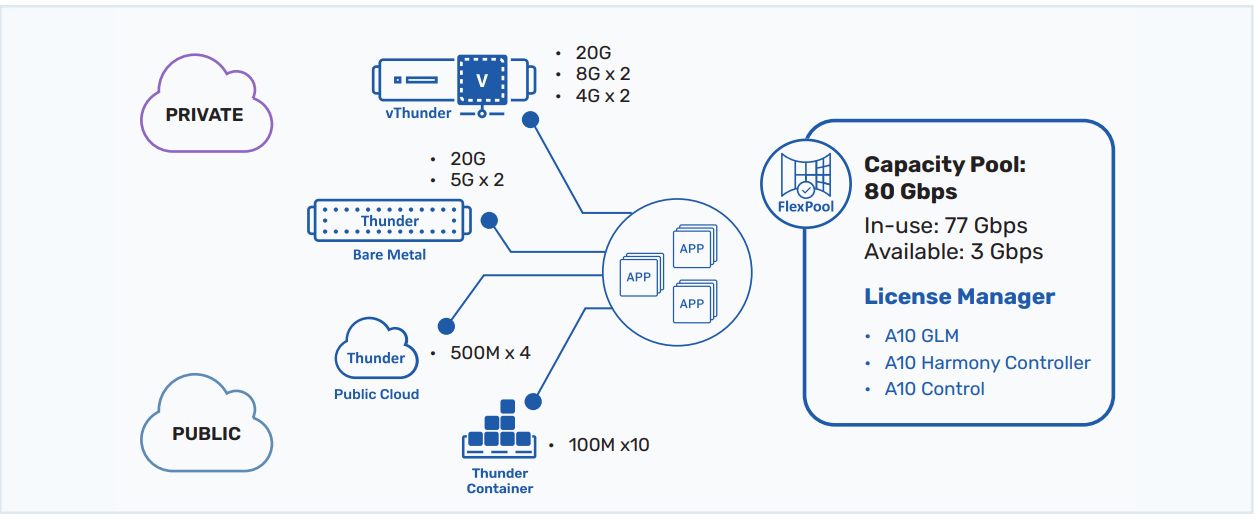Modernizing Your Application Infrastructure with Flexible Licensing from A10
Make Application Delivery Deployment Easier, Flexible, and Cost-effective for Your Business
Consumption of Secure Application Services is Changing
Revered for its versatility, hybrid cloud’s popularity skyrocketed over the last decade, significantly changing how infrastructure is designed and managed. Concurrently, the application landscape took on a new form. Developers began producing more cloud and container-based applications, demanding greater agility and scalability from the underlying infrastructure.
New applications are primed for growth and flexibility. Yet, the legacy licensing schemes of application delivery solutions, which are meant to improve performance and load balancing, remain static and with fixed capacity. To complicate things further, administrators running a hybrid environment are forced to manage application delivery instances across multiple clouds and on-premises, which is difficult, time consuming, and costly. While many organizations still face this disconnect, there are now new options available that can make life easier for IT administrators.
Overcoming Licensing Problems
Managing and ensuring the right license for a solution has always been a headache for enterprises and service providers. Traditional solutions with inaccurate capacity planning create monetary issues. Many businesses over-provision to ensure resource availability, which results in overspending. Others underestimate future needs and risk service outages. Both approaches require significant capital outlays and have long procurement cycles in case a customer wants to course correct. This limits IT agility and restricts business operations, prompting organizations to seek a flexible licensing model for any location that can scale as requirements grow over time.
Perpetual, fixed-capacity licenses tied to a single physical or virtual appliance will continue to exist. These are best suited for organizations with limited deployment sizes or those using a single cloud or on-premises platform. However, in large and multi-cloud environments, license portability and scalability become extremely important.
Application workload requirements are in constant flux. Modern businesses require a licensing model that matches their need for real-time deployment flexibility. This includes support for hybrid cloud, virtual, bare metal, and on-premises deployments. Organizations that want to improve their agility and ensure automation across enterprise and cloud environments will need different options to modernize the delivery of dynamic application services.
A10 solved these problems by modernizing licensing with three options:
- Fixed licensing for software platforms
- Modular licensing for hardware platforms
- FlexPool licensing for software platforms
To help you decide what licensing option is right for your organization’s environment, this paper will review each option and describe use cases where they best apply.
Fixed Licensing for Software Platforms
Today, many organizations currently use a fixed capacity license for their software-based solution. In these situations, the business downloads and installs an appliance and then activates it with their license based on how much bandwidth throughput it needs. Purchasing options are either perpetual or in increments such as one- and three-year subscriptions. However, licenses are locked and are not portable or flexible to increase bandwidth if the need arises. This is suited for organizations with a predictable model and knowledge of the exact requirements for the next three to five years.
| Benefits of Fixed Licensing |
|---|
|

Figure 1: Individual bandwidth is licensed on each product. In this case, total managed licenses are 4x 5Gbps, 2x 5Gbps and 2x 500Mpbs.
When to Use a Fixed Capacity License
Maintaining Stable and Consistent Services with a Cost-effective Solution
The fixed model licensing option is straightforward to manage because it has one license per appliance. It’s also the best choice if your organization is small and has a predictable model with a set-and-forget deployment.
Modular Licensing for Hardware Platforms
Historically, if your hardware worked and technology providers supported the software, organizations could pay once and use it for the life of the platform. As traffic grows and application delivery and security requirements demand higher throughput and capacity, organizations need a way to scale up service capacity without replacing the hardware.
| Benefits of Modular Licensing |
|---|
|
Modular licensing solves this by decoupling hardware and software layers. Doing so allows an organization to scale up dynamically with just a license update on the software. This is broken down as:
- Zero-capacity hardware: Allows the purchasing of a hardware platform that can scale over time
- Software with modular capacity license: An organization can pay for the capacity they currently need and also upgrade the license to unlock capacity and throughput as demands increase

Figure 2: Pay-as-you-grow model, allowing capacity upgrades without replacing the hardware to support future growth.
When to Use a Modular License
Ensuring Service Quality and Improving Resiliency for Critical Apps and Workloads
Accurately predicting current and future service volume/capacity, including seasonality, is key for better operation. When the capacity is insufficient and requires hardware replacement, organizations will incur maintenance and downtime, along with an extra cost for purchasing new hardware. In these instances, modular licensing allows organizations to increase capacity to maintain their service level without replacing the hardware appliance. Should they need to upgrade capacity, it is done in the background, without affecting or interrupting service.
Building a Cost-efficient and Scalable Solution that is Primed for Future Growth
Organizations on a tight budget from day-one, that want to be ready to grow, no longer have to worry about paying for full capacity from the start. With a modular license, they can purchase a higher-end capacity appliance that can scale as the demand grows. As the business expands, they can upgrade the capacity by updating the software license, without replacing the hardware, to meet demands and ensure service quality
FlexPool Licensing for Software Platforms
Network and service capacity are difficult to determine in homogenous environments. This becomes even more complex when distributed across multiple clouds and on-premises data centers in a hybrid environment. Flexible capacity licensing offers greater value, lower costs, and portability to allow for future capacity planning. It gives organizations the choice they want with a pool of licenses that can move across virtual, bare metal, and hybrid cloud infrastructures.
With flexible licensing, organizations can dynamically and flexibly allocate capacity and share the pool as needed—anywhere and anytime. This prevents service disruption because administrators can mix and match instances and create them instantly and scale them for on-demand consumption.
| Benefits of FlexPool Licensing |
|---|
|

Figure 3: Capacity pooled licensing that allows flexible capacity allocation and license portability across any clouds
When to Use a Flexible License
Migrating Infrastructure to a Modern Approach
Whether virtualization, DevOps, or automation, to support modern service architecture, the solution needs to be flexible, portable and scalable.
This can happen in three ways:
- The instance capacity can be scalable/changeable
License needs to allow either increase or decrease - The instance can move to another host or location
License needs to be migrated/transferred - The instance can be replaced with newly created instance for software upgrades, troubleshooting purpose, etc.
License need to be re-allocated to a new instance
Flexible licensing can easily achieve any or all of these three processes and can automate the workflow to increase operational efficiency.
Building a Muti-cloud Application Service Across Multiple Clouds
Organizations that are cloud-first, and looking to deploy software-based solutions, should consider FlexPool as their first option. With clouds, there may be license restrictions for portability across public clouds or between private and public clouds. These complexities can make license and cost management challenging. With FlexPool licenses, organizations can have their pick of cloud environments and share capacity across different clouds. Administrators can release capacity instantly and allocate to a new cloud without slowdowns.
Conclusion
Improving the efficiency in consumption of secure application delivery doesn’t have to be hard.
With A10, you can choose a licensing model that best suits your environment.
Fixed LicensingFor smaller organizations using on-premises or a single cloud with a static deployment and predictable traffic volume. Modular LicensingFor hardware solution users needing a cost-efficient and scalable service that is primed for growth with a pay-as-you-grow model FlexPool Capacity LicensingFor software users requiring a modern approach to build multi- and hybrid-cloud application delivery infrastructure; best suited for deploying several software-based appliances, anywhere | By providing flexible options for managing capacity and software licenses, customers can achieve greater business value, easy license portability, and ongoing innovation. No matter your use case for secure application services, you can efficiently plan capacity and licensing expenses while preparing for future infrastructure environments. |
Next Steps
Experience secure, agile, and programmable application delivery with A10 vThunder with our 30-day free trial at: www.a10networks.com/products/vthunder-trial/
About A10 Networks
A10 Networks provides security and infrastructure solutions for on-premises, hybrid cloud, and edge-cloud environments. Our 7000+ customers span global large enterprises and communications, cloud and web service providers who must provide business-critical applications and networks that are secure, available, and efficient.
Founded in 2004, A10 Networks is based in San Jose, Calif. and serves customers globally. For more information, visit: A10Networks.com or tweet @a10Networks